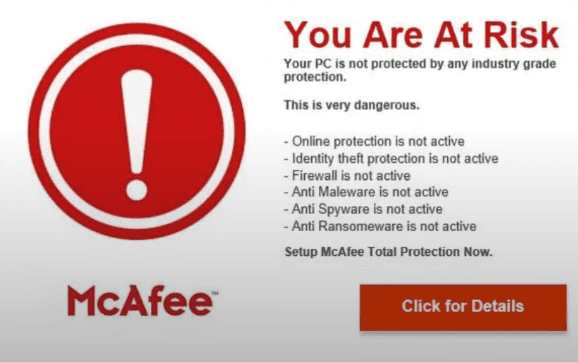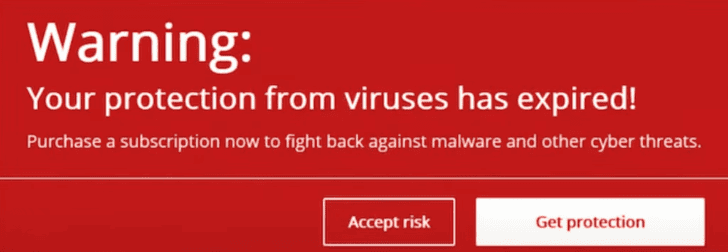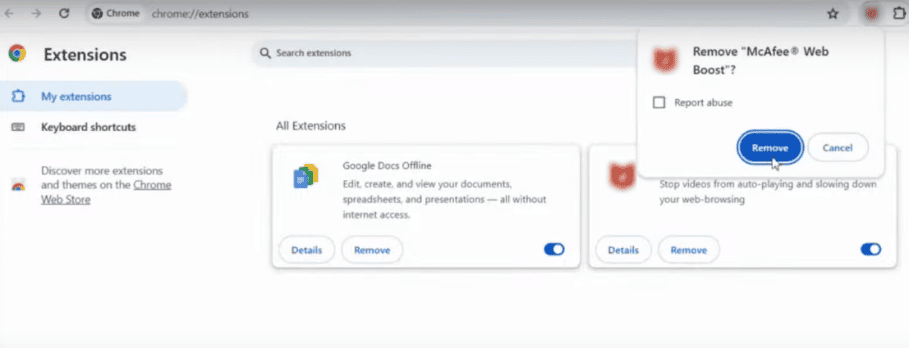How to Stop McAfee Pop-ups
If you’re tired of those constant McAfee pop-ups interrupting your browsing or work, you’re not alone. Many users across Windows and Mac systems are actively searching for how to stop McAfee pop-ups because these notifications can appear repeatedly — even when you think you’ve disabled them or, surprisingly, when McAfee isn’t even installed on your device.

These pop-ups are designed to alert you about important updates, subscription renewals, or potential security risks. While legitimate McAfee alerts are meant to protect your system, they can quickly become overwhelming if they appear too frequently. On the other hand, some pop-ups that look like they’re from McAfee are not genuine at all — they’re fake scam pop-ups created by malicious websites or adware to trick you into downloading unwanted software.
In this blog, we’ll cover everything you need to know about how to get rid of McAfee pop-ups, whether they’re real or fake. You’ll learn step-by-step methods for McAfee pop-up removal, ways to block McAfee pop-ups in your browser and system settings, and preventive measures to make sure they don’t return.
Whether you’re using Windows or macOS, this article has you covered. If you keep getting McAfee pop-ups on Windows 11 or 10, we’ll show you the exact settings to change to silence them for good. If you’re on a Mac and wondering how to stop McAfee pop-ups on Mac, you’ll find easy solutions tailored for Apple users too.
By the end of this blog, you’ll know how to stop McAfee pop-ups completely, understand why they appear in the first place, and gain control over your device’s notifications once again. So, let’s dive in and finally stop McAfee pop-ups from taking over your screen — once and for all.
Why McAfee Pop-ups Occur
If you keep getting McAfee pop-ups, it’s important to understand why they appear before you can effectively deal with them. These notifications generally fall into two categories — legitimate McAfee alerts and fake or scam pop-ups that imitate the McAfee brand. Knowing the difference between the two is the first step toward successful McAfee pop-up removal and preventing them from reappearing.

1. Legitimate McAfee Notifications
- McAfee, like most antivirus programs, sends legitimate alerts to help users stay protected. These can include subscription renewal reminders, software update prompts, or security scan notifications. While these messages are designed to keep your system secure, they can quickly become annoying when they appear too frequently — especially if you’re in the middle of working or browsing online.
- If you’re trying to figure out how to stop McAfee pop-ups from the official app, the good news is that you can reduce or disable them through McAfee’s built-in settings. Within the app, go to the Notifications or Alerts section and turn off promotional messages or non-critical alerts. This is one of the easiest ways to get rid of McAfee pop-ups without compromising your device’s security.
- Whether you’re on a Mac or PC, you can stop McAfee pop-ups on Windows 11 or learn how to stop McAfee pop-ups on Mac by adjusting the notification settings in your operating system as well.
2. Fake / Scam Pop-ups Disguised as McAfee
- A much more serious and frustrating issue arises when you keep getting McAfee pop-ups even though McAfee isn’t installed on your device. In most cases, these are fake pop-ups — deceptive ads or “scareware” designed to look like real McAfee notifications. These fraudulent messages often warn you about non-existent viruses and push you to click malicious links or download unsafe software.
- Such pop-ups typically originate from malicious websites or browser notifications you may have accidentally allowed. They exploit McAfee’s trusted brand name to trick users into taking harmful actions. To get rid of McAfee pop-ups of this kind, you’ll need to remove unwanted browser notifications, clear adware, and block McAfee pop-ups through your browser’s security settings.
- Understanding whether your alerts are legitimate or fake is crucial — because only then can you effectively stop McAfee pop-ups and maintain a smooth, secure browsing experience.
Identify if the McAfee Pop-up is Real or Fake
Before you can successfully get rid of McAfee pop-ups, it’s crucial to identify whether the notifications you’re seeing are genuine or fake. This distinction determines the right method to use for McAfee pop-up removal — because what works for real alerts won’t necessarily help with scam ones. Many users keep getting McAfee pop-ups without realizing they’re actually coming from malicious websites or adware pretending to be McAfee.
Below, we’ll look at some visual cues, red flags, and verification steps that will help you determine if the pop-ups are legitimate or part of a scam. Once you’ve identified their source, you’ll know exactly how to stop McAfee pop-ups effectively on your system.
1. Visual Cues and Red Flags
Fake or scam McAfee pop-ups are often designed to create a sense of urgency — messages like “Your computer is infected!” or “Your McAfee subscription has expired!” flash across the screen, pushing you to click “Renew Now” or “Clean System.” But these are classic scare tactics used by cybercriminals.
Here are some clear visual red flags that help you spot these fake alerts:
-
Poor grammar or spelling mistakes:
Real McAfee notifications are professionally written, while scam ones often contain obvious errors.
-
Pixelated or distorted McAfee logos:
Counterfeit pop-ups use low-quality images or off-brand colors.
-
Unusual URLs or browser pop-ups:
Legitimate McAfee alerts never appear through random websites or pop-up ads. They only appear from within the McAfee application interface or official email communications.
-
Aggressive or threatening language:
If the message demands immediate action or tries to scare you into clicking, it’s likely fake.
If you notice any of these issues, you’re not dealing with a real McAfee notification. Instead, it’s likely adware or a phishing attempt — and you’ll need to remove McAfee pop-ups of this type by cleaning your browser or removing malicious extensions.
2. Check if McAfee is Actually Installed
Another simple but often overlooked step is checking whether McAfee is actually installed on your computer. If you keep getting McAfee pop-ups even though you never installed the software, that’s a strong indicator the alerts are fake.
To verify this:
- On Windows 11, open Settings → Apps → Installed Apps and look for McAfee in the list.
- On Mac, go to Applications and check if a McAfee folder or app exists.
If McAfee isn’t installed but you’re still receiving notifications, it’s a clear sign that the pop-ups are being generated by a malicious website or adware. In that case, your next step is to block McAfee pop-ups from your browser by turning off notification permissions for suspicious sites.
Once you’ve identified that the alerts are fake, you can confidently proceed to stop McAfee pop-ups on Windows 11 or Mac by cleaning your system and browser settings.
How to Disable Genuine McAfee Pop-ups
If you’ve confirmed that your notifications are legitimate and coming directly from the McAfee app, the good news is — you can stop McAfee pop-ups easily by tweaking a few settings. McAfee’s built-in alerts are meant to keep you informed about potential threats, software updates, or subscription renewals, but for many users, they can become unnecessarily repetitive and distracting.

How to Disable Genuine McAfee Pop-ups
Whether you’re on Windows 11 or macOS, you can follow the steps below for complete McAfee pop-up removal without turning off your antivirus protection. By adjusting McAfee’s alert settings and your system’s notification preferences, you can effectively get rid of McAfee pop-ups and enjoy a smoother, quieter user experience.
1. Windows (System Notifications + McAfee Settings)
If you keep getting McAfee pop-ups on Windows 11 or 10, the first step is to adjust your Windows notification settings. Windows allows you to control which applications are allowed to send alerts — including McAfee.
Here’s how to do it:
- Click Start → Settings → System → Notifications & Actions.
- Scroll down to the section labelled “Notifications from apps and other senders.”
- Locate McAfee in the list of apps.
- Toggle off notifications for McAfee if you want to block McAfee pop-ups completely, or adjust them to only show critical alerts.
Once you’ve handled system notifications, it’s time to fine-tune settings inside the McAfee app itself:
- Open the McAfee application on your PC.
- Navigate to Settings → General Settings → Alerts & Notifications (the exact path may vary slightly by version).
- Uncheck options related to informational, promotional, or non-critical alerts.
- Save your changes.
By doing this, you’ll remove McAfee pop-ups related to product news, promotions, and reminders, while keeping only essential security alerts active. This ensures that your antivirus continues to protect your system while staying out of your way.
If you’re still seeing alerts after these changes, try restarting your computer to ensure the settings take effect. This simple process is often all you need when you want to stop McAfee pop-ups on Windows 11 effectively.
2. Disable McAfee Pop-ups on macOS
For Mac users wondering how to stop McAfee pop-ups on Mac, the process involves a mix of system and browser adjustments.
First, check the McAfee app settings on your Mac:
- Open the McAfee Security application.
- Go to Preferences → Notifications.
- Deselect or disable any marketing or non-essential alerts.
Next, if you’re using Safari, you may also want to review your notification permissions, as websites sometimes send alerts that appear similar to McAfee messages:
- Open Safari → Preferences → Websites → Notifications.
- Review the list of sites allowed to send notifications.
- Select any suspicious or unwanted websites and click Remove or Deny.
These steps will help to get rid of McAfee pop-ups that originate from Safari or other browsers, ensuring that only the official McAfee app can communicate necessary security information.
3. Browser Extensions or Web Notifications
Sometimes, even after adjusting your antivirus and system settings, you may keep getting McAfee pop-ups that actually come from browser permissions. This often happens when you’ve accidentally allowed a website to send notifications.
Here’s how to remove McAfee pop-ups caused by browser permissions:
-
Google Chrome:
-
- Open Chrome → Settings → Privacy and Security → Site Settings → Notifications.
- Review the “Allowed to send notifications” list.
- Find and remove any websites pretending to be McAfee or that look suspicious.
-
Microsoft Edge:
-
- Go to Settings → Cookies and Site Permissions → Notifications.
- Remove any sites that shouldn’t have permission to send notifications.
Once these permissions are cleared, you’ll effectively block McAfee pop-ups triggered by browser scams or push notifications.
By following these platform-specific steps, you can get rid of McAfee pop-ups once and for all — whether they’re coming from your antivirus software, Windows system alerts, or browser notifications. Adjusting these settings not only declutters your desktop but also strengthens your system against potential phishing or scam attempts. With a few quick changes, you’ll finally know how to remove McAfee pop-ups safely and enjoy a distraction-free experience on both Windows and Mac.
How to Stop Fake McAfee Pop-ups / Scams
If you keep getting McAfee pop-ups even though you don’t have McAfee installed, chances are you’re dealing with fake McAfee pop-ups — deceptive messages created by scammers or malicious websites to trick you into clicking dangerous links. These pop-ups often claim your computer is “infected” or that your “subscription has expired,” urging you to download something or enter personal information.

Such fraudulent alerts are part of adware, browser hijackers, or scareware campaigns that imitate McAfee’s brand identity. To protect yourself, you need to take immediate steps for McAfee pop-up removal — which involves cleaning up your browser, removing unwanted software, and scanning your system for hidden threats. Below are the most effective ways to get rid of McAfee pop-ups safely and permanently.
1. Browser Notification Settings & Site Permissions
One of the most common reasons users keep getting McAfee pop-ups is that they’ve unknowingly granted notification permissions to malicious websites. These sites continuously push fake alerts that look identical to McAfee warnings.
To block McAfee pop-ups from your browser, follow these steps:
-
Google Chrome:
-
- Open Chrome → Settings → Privacy and Security → Site Settings → Notifications.
- Under “Allowed to send notifications,” find any unfamiliar or suspicious sites.
- Click the three dots next to them and choose Remove or Block.
-
Microsoft Edge:
-
- Go to Settings → Cookies and Site Permissions → Notifications.
- Review the allowed list and delete any shady websites.
-
Safari (macOS):
-
- Go to Safari → Preferences → Websites → Notifications.
- Remove any site you don’t recognize or trust.
These simple steps instantly tell us how to stop McAfee pop-ups on Mac that come through browser permissions.
2. Remove Adware / Unwanted Extensions
Many fake pop-ups originate from adware programs or browser extensions that have been silently installed on your device. These components inject unwanted ads and redirect you to scam pages.
To get rid of McAfee pop-ups, open your browser’s Extensions or Add-ons menu and uninstall anything you don’t remember installing. Look for suspicious names or plugins related to security, cleanup, or “free virus checks.”
You can also use trusted adware removal tools or anti-malware scanners to perform a thorough McAfee pop-up removal. Apps like Malwarebytes or AdwCleaner are excellent for cleaning up adware infections that cause fake pop-ups.
3. Run a Full Anti-Malware Scan
- If fake alerts keep appearing after cleaning your browser, it’s possible your system is infected with deeper malware. In this case, running a full anti-malware scan is essential.
- A comprehensive system scan can remove McAfee pop-ups caused by hidden scripts or background programs. It also eliminates potential spyware, trojans, and other threats that hijack browser settings.
- Once the scan is complete, restart your device to finalize the cleanup. Afterward, you’ll finally stop McAfee pop-ups and prevent them from coming back.
- By following these steps, you can confidently stop McAfee pop-ups — whether they appear in your browser, desktop notifications, or during web browsing sessions. Staying cautious about what you click and regularly scanning your system ensures lasting protection against these fake McAfee scams.
Complete Removal of McAfee (If You No Longer Want McAfee)
If you’ve tried every method to stop McAfee pop-ups but still keep getting McAfee pop-ups, it might be time to remove the program entirely. Sometimes, even after disabling notifications, background McAfee processes or leftover files continue to trigger alerts. Performing a complete uninstall ensures total McAfee pop-up removal and prevents any future interruptions.

1. Uninstall Steps
The first step to get rid of McAfee pop-ups completely is to uninstall the program from your system.
For Windows users:
- Click Start → Settings → Apps → Installed Apps (or Apps & Features).
- Scroll down to find McAfee in the list.
- Select it and click Uninstall.
- Follow the on-screen instructions to complete the process.
After uninstalling, restart your computer to ensure all related files are removed. If you stop McAfee pop-ups on Windows 11 and still see them afterward, it’s likely that some remnants of the program are still present — that’s where the next step comes in.
For Mac users, drag the McAfee application from the Applications folder into the Trash, then empty the Trash. This will remove McAfee pop-ups associated with the app on macOS.
2. Use McAfee Consumer Product Removal Tool (MCPR)
- To ensure a complete cleanup, download and run the McAfee Consumer Product Removal Tool (MCPR) from the official McAfee website. This tool deletes leftover components, registry entries, and background files that standard uninstallation might miss.
- Running the MCPR tool is one of the most effective ways to get rid of McAfee pop-ups It guarantees full McAfee pop-up removal, leaving your device clean and free of unwanted alerts.
- Once the process is finished, restart your system — you’ll finally remove McAfee pop-ups, regain control of your device, and stop those intrusive notifications for good.
Prevent Future McAfee Pop-ups
Once you’ve successfully managed to stop McAfee pop-ups, the next crucial step is prevention. Pop-ups — whether legitimate notifications or fake scam alerts — often reappear due to unsafe browsing habits, outdated software, or accidental permission grants to malicious websites. To ensure that you never keep getting McAfee pop-ups again, it’s important to follow a few simple but effective maintenance and security practices.

Below are three excellent methods to stop McAfee pop-ups from returning and to keep your device free from similar unwanted alerts in the future.
1. Keep Software Updated
Regularly updating your software is one of the most powerful ways to prevent McAfee pop-ups and other intrusive notifications. Outdated operating systems and browsers are more vulnerable to adware, malware, and fake pop-ups disguised as antivirus warnings.
When you keep Windows, macOS, and your browsers up to date, you’re installing important security patches that help stop McAfee pop-ups and similar scam messages.
-
Windows users:
Enable automatic updates through Settings → Windows Update. This is especially important if you want to stop McAfee pop-ups on Windows 11, as newer updates improve system-level ad and notification controls.
-
Mac users:
Go to System Preferences → Software Update to ensure your device is running the latest version of macOS — a key step in how to stop McAfee pop-ups on Mac effectively.
By maintaining updated software, you greatly reduce the risk of fake pop-up attacks and improve overall system performance.
2. Avoid Risky Websites and Downloads
Many fake McAfee alerts come from unreliable or high-risk websites that try to trick users into enabling notifications. Once you grant permission, these sites start sending endless fake antivirus alerts, leading you to search for how to remove McAfee pop-ups again.
To stay safe:
- Avoid clicking suspicious ads or “free scan” buttons.
- Don’t download software from unverified sources.
- Double-check website URLs before entering personal information.
Developing these browsing habits will help you get rid of McAfee pop-ups permanently and safeguard your system from similar scams.
3. Use Ad-Blockers and Notification Blockers
Another effective strategy to remove McAfee pop-ups and prevent future ones is to use ad-blockers and notification blockers.
- Install trusted browser extensions such as uBlock Origin, AdGuard, or Privacy Badger to block intrusive pop-ups and unwanted ads.
- In your browser settings, disable notifications globally or only allow them for trusted websites.
These tools make it easy to stop McAfee pop-ups from ever appearing — especially those originating from malicious or ad-heavy websites.
By following these proactive measures — keeping your software updated, avoiding shady websites, and using blockers — you can confidently get rid of McAfee pop-ups, prevent their return, and enjoy a safer, distraction-free online experience.
FAQs
Q1. Why do I keep getting McAfee pop-ups even after uninstalling the software?
- A. If you keep getting McAfee pop-ups after uninstalling the program, it’s likely because of leftover files, adware, or fake pop-ups from malicious websites. Run the McAfee Consumer Product Removal tool (MCPR) to remove any residual files, and check your browser’s notification settings to block McAfee pop-ups from scam sites.
Q2. How can I tell if a McAfee pop-up is real or fake?
- A. To identify real vs fake alerts, check for spelling mistakes, pixelated logos, or aggressive messages. Genuine notifications come from the McAfee app or system tray, not from browsers. Recognizing this difference is the first step in how to get rid of McAfee pop-ups safely.
Q3. How to stop McAfee pop-ups on Windows 11?
- A. To stop McAfee pop-ups on Windows 11, go to Settings → System → Notifications & Actions, then disable notifications for McAfee. Inside the McAfee app, open Settings → Alerts & Notifications and uncheck promotional messages. This ensures effective McAfee pop-up removal while keeping important alerts active.
Q4. How to stop McAfee pop-ups on Mac?
- A. To stop McAfee pop-ups on Mac, open the McAfee app, go to Preferences → Notifications, and disable marketing alerts. Also, open Safari → Preferences → Websites → Notifications and remove any suspicious sites that may be mimicking McAfee.
Q5. Will uninstalling McAfee help me get rid of pop-ups completely?
- A. Uninstalling McAfee removes legitimate alerts, but if you keep getting McAfee pop-ups after that, it’s likely due to adware or fake notifications. Use the MCPR tool for complete McAfee pop-up removal and clean your browser settings to ensure no scam sources remain.
Q6. How can I prevent McAfee pop-ups in the future?
- A. To stop McAfee pop-ups permanently, keep your software updated, avoid suspicious sites, and use reliable ad-blockers. Regular maintenance and cautious browsing are the best long-term solutions to get rid of McAfee pop-ups and prevent them from returning.
Conclusion
Dealing with constant antivirus alerts can be frustrating, especially when you keep getting McAfee pop-ups that interrupt your work or browsing sessions. Fortunately, understanding the difference between legitimate McAfee notifications and fake scam pop-ups gives you complete control over your device. By following the right steps, you can successfully get rid of McAfee pop-ups once and for all and prevent them from coming back.
The first step is identifying whether the pop-ups are real or fake. Genuine alerts come directly from the McAfee application, while fake ones appear from browsers or malicious websites pretending to be McAfee. Once you’ve determined their source, you can stop McAfee pop-ups using the right approach.
For legitimate notifications, access your McAfee settings to disable promotional or non-essential alerts. On Windows, adjust your system’s Notifications & Actions panel to limit pop-ups from McAfee. On macOS, you can manage these alerts through the McAfee preferences panel or Safari’s website permissions. This process helps you remove McAfee pop-ups safely without affecting your antivirus protection.
If the pop-ups are fake or scam-based, handle them by clearing browser notification permissions, uninstalling adware or unwanted extensions, and running a full anti-malware scan. These actions ensure complete McAfee pop-up removal and protect your system from deceptive advertisements in the future.
Once you’ve cleaned up your system, develop habits that prevent these issues from returning. Keep your operating system and browsers updated, avoid risky websites, and install ad-blockers to block McAfee pop-ups and similar scams.
Whether you’re trying to stop McAfee pop-ups on Windows 11 or learning how to stop McAfee pop-ups on Mac, these simple yet effective strategies will help you maintain a secure and seamless digital experience. With consistent maintenance and caution, you’ll finally get rid of McAfee pop-ups permanently and enjoy uninterrupted use of your device.
For more information regarding McAfee, go to our McAfee Support page.

